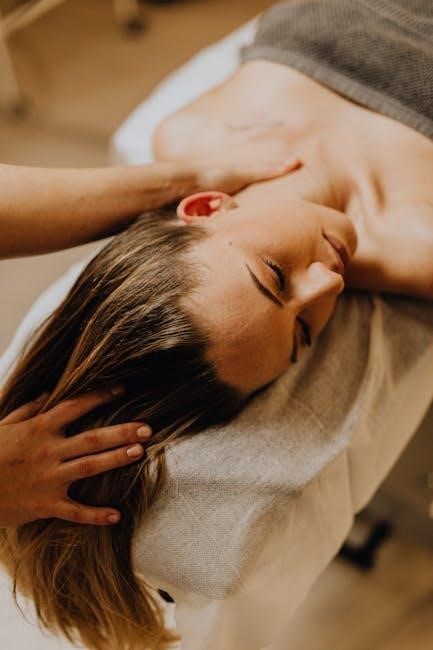The neck is a vital anatomical region containing the cervical spine, larynx, thyroid gland, lymph nodes, and vital nerves. These structures support essential functions like movement, breathing, and blood circulation.
1.1 Key Structures of the Neck
The neck contains the cervical spine, which supports the head and facilitates movement. Key structures include the larynx (voice box), thyroid gland, and lymph nodes. The cervical plexus, a network of nerves, regulates sensation and muscle function. Blood vessels like the carotid arteries and jugular veins ensure proper circulation. These components work together to enable essential functions such as breathing, swallowing, and maintaining posture. Understanding these structures is crucial for appreciating neck health and function.
1.2 The Role of the Cervical Spine
The cervical spine, comprising seven vertebrae, provides structural support for the head and enables a wide range of motion. It protects the spinal cord, which is vital for transmitting nerve signals between the brain and body. The cervical spine also plays a crucial role in maintaining proper posture and facilitating functions like swallowing and breathing. Its discs and ligaments work together to absorb shock and provide stability, ensuring overall neck health and mobility. This complex structure is essential for daily activities and overall well-being.
1.3 Understanding the Larynx, Thyroid, and Lymphatics
The larynx, or voice box, facilitates breathing and speech, while the thyroid gland regulates metabolism through hormone production. Lymph nodes in the neck act as filters for harmful substances, supporting immune function. These structures are interconnected, playing vital roles in communication, digestion, and overall health. Their proper functioning ensures clear speech, balanced metabolism, and effective immune response, making them essential components of the neck’s anatomical framework.

Common Causes and Prevention of Neck Pain
Neck pain often arises from poor posture, stress, or muscle strain. Regular exercises, ergonomic adjustments, and stress management can help prevent and alleviate neck tension effectively.
2.1 Understanding Neck Pain Statistics and Prevalence

Research indicates that 22% to 70% of the population experiences neck pain at some point in their lives, with prevalence increasing due to modern lifestyles. At any given time, 10% to 20% report neck issues, and 54% have experienced it previously. Women are more frequently affected than men. These statistics highlight the widespread nature of neck pain, emphasizing the need for preventive measures to reduce its societal impact.

2.2 Risk Factors for Developing Neck Pain
Neck pain affects 22-70% of people, with women more prone. Risk factors include poor posture, stress, repetitive motions, and lack of exercise. Occupational hazards and improper ergonomics exacerbate issues. Addressing these factors is key to prevention and maintaining neck health.
2.3 Preventive Measures for Reducing Neck Tension
Preventing neck tension involves maintaining good posture, using ergonomic furniture, and taking regular breaks from sedentary activities. Strengthening neck muscles through targeted exercises and applying heat or ice packs can alleviate strain. Avoiding excessive screen time and ensuring proper neck support during sleep are also effective strategies. Regular stretching and mindfulness of daily habits can significantly reduce the risk of developing neck pain.

A Comprehensive Guide to Neck Strengthening
Neck strengthening is crucial for overall health, reducing injury risk, and improving posture. Targeted exercises and ergonomic strategies enhance muscle endurance and spinal alignment naturally.
3.1 Importance of Neck Strength for Overall Health
Neck strength is vital for maintaining posture, preventing injuries, and supporting daily activities. Weak neck muscles can lead to chronic pain and limited mobility, while strong neck muscles enhance athletic performance and reduce the risk of strain. Proper neck strength also improves spinal alignment, promoting overall musculoskeletal health and reducing the likelihood of long-term discomfort or disability.
3.2 Effective Exercises for Neck Strengthening
Strengthening the neck involves targeted exercises like the Tuck and Rotate, where you tuck your chin and rotate your head gently. Side Bend exercises stretch and tone the lateral muscles. Chin Tucks, performed by lowering your head while keeping your jaw straight, improve posture and strength. Using tools like the Denneroll cervical orthotic device can also enhance these exercises, ensuring proper alignment and maximizing effectiveness for overall neck health.
3.4 Ergonomic Strategies to Support Neck Health
Implementing ergonomic strategies is crucial for neck health. Adjust your workstation to ensure your monitor is at eye level and documents are at eye height to avoid constant looking down. Use ergonomic pillows designed for cervical support, like the Tempur-Neck pillow, to maintain proper alignment during sleep. Regularly take breaks to stretch and move, especially if working at a desk. Incorporating tools like the Anysize Neck Guide can also help maintain proper posture and reduce strain on the neck muscles.

Neck Grooming and Maintenance
Neck grooming tools like Skull Shaver’s Neck Guide and Neckline Shaving Templates help achieve clean, defined necklines. Regular trimming prevents uneven hair growth and maintains a polished look.
4.1 Tools for Trimming and Shaping Neck Hair
Essential tools for neck grooming include the Neckline Shaving Template Guide, Skull Shaver’s Neck Guide, and Anysize Neck Guides. These tools offer precise trimming and shaping, ensuring clean, defined necklines. The Neckline Shaving Template provides straight or curved edges, while Skull Shaver’s elastic headband allows hands-free trimming. Anysize Guides adjust to various neck flange sizes, making them versatile for different needs. These tools help maintain neat, professional-looking necklines effortlessly.
4.2 DIY Guide for a Perfect Neckline
Achieve a polished neckline with a DIY approach using tools like the Neckline Shaving Template Guide. Define your natural hairline by placing the guide along your desired edge. Use clippers or a razor for precise trimming, ensuring symmetry. Regular maintenance prevents uneven growth. For curved looks, align the guide accordingly. Combine with tools like Skull Shaver’s Neck Guide for hands-free accuracy. Maintain a clean, sharp appearance by trimming every few days and using heat or ice packs to soothe skin after shaving.
4;3 Tips for Maintaining a Clean and Defined Neckline

Maintaining a clean neckline involves regular trimming and precise grooming tools. Use guides like the Neckline Shaving Template for straight or curved lines. Trim in one direction to avoid ingrown hairs and exfoliate skin to prevent irritation. Apply heat packs or ice to soothe post-shave discomfort. Keep the area moisturized to maintain smoothness. Regular touch-ups ensure a defined look, while proper hygiene prevents razor burn. Combine these practices for a polished, professional appearance that enhances your overall style.

The Cultural and Artistic Significance of the Neck
The neck is a canvas for artistic expression, from Modigliani’s elongated forms to neck tattoos symbolizing personal identity. It embodies strength, sensuality, and cultural symbolism in art and fashion.
5.1 The Neck in Art History and Modern Expression
The neck has long been a focal point in art, symbolizing elegance and strength. In art history, Modigliani famously elongated necks for surreal effect, while modern artists explore its expressive potential. Today, the neck is a canvas for tattoos, blending personal identity with cultural narratives. Its depiction in portraits and sculptures highlights its enduring significance as a symbol of beauty and power, bridging tradition and contemporary self-expression.
5.2 Neck Tattoos as a Form of Self-Expression
Neck tattoos have emerged as a bold and unique form of self-expression, blending personal identity with artistic creativity. Many individuals choose this canvas to convey meaningful stories, symbols, or cultural narratives. From minimalistic designs to intricate patterns, neck tattoos allow wearers to showcase their individuality. While this form of art is gaining popularity, it remains a significant commitment due to its visibility and potential cultural perceptions, making it a powerful statement of personal identity and style.
5.3 The Neck as a Symbol in Fashion and Culture
The neck has long been a focal point in fashion and culture, symbolizing elegance, strength, and sophistication. From statement jewelry to scarves, it serves as a canvas for personal style. In art history, elongated necks were often depicted to signify grace, as seen in Modigliani’s portraits. Culturally, the neck represents a bridge between the head and heart, embodying balance and poise. Its prominence in fashion highlights its role as a versatile and expressive feature, reflecting both individuality and societal trends.

Ergonomics and Posture for Neck Health
Proper ergonomics and posture are crucial for neck health. Adjusting workstations, using supportive pillows, and avoiding prolonged screen time can prevent strain. Regular stretches and awareness of posture help maintain alignment and reduce tension, promoting long-term neck well-being.
6.1 The Impact of Technology on Neck Posture

Modern technology significantly impacts neck posture, as frequent use of smartphones, computers, and tablets often leads to forward head posture and muscle strain. Prolonged screen time encourages individuals to bend their necks downward, causing misalignment of the cervical spine. This repetitive strain can result in long-term discomfort and increased risk of chronic neck pain. regular breaks, ergonomic adjustments, and mindful posture practices are essential to mitigate these effects and promote healthier neck alignment.
6.2 Simple Stretches to Relieve Neck Tension
Simple stretches can effectively alleviate neck tension. The chin tuck strengthens neck muscles by tucking the chin toward the chest and holding for 15-30 seconds. Side-to-side neck bends involve gently tilting the head to bring the ear toward the shoulder, holding for 10 seconds on each side. The ear-to-shoulder stretch relaxes the neck and shoulder muscles by bringing the ear to the shoulder and holding for 20-30 seconds. Regular practice improves mobility and reduces stiffness.
6.3 Recommended Pillows for Neck Support
For optimal neck support, consider memory foam pillows like the Tempur-Neck pillow, which cradles the head and neck to alleviate pain. Cervical pillows, such as those with a contoured design, promote proper spinal alignment. Adjustable pillows like the Coop Home Goods Memory Foam Pillow allow customization to suit individual needs. Additionally, the Snuggle-Pedic Kool-Flow Pillow provides breathable comfort and support. Using the right pillow can significantly improve sleep quality and reduce neck strain;